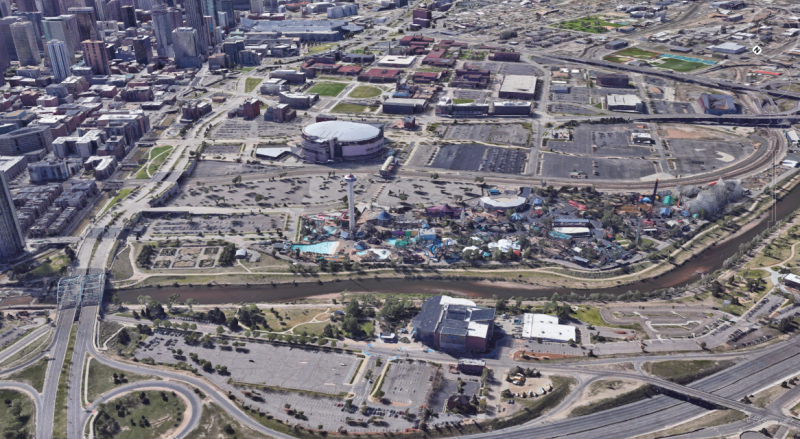America’s Worst Parking Crater Could Become Denver’s Next Human-Scale Neighborhood
Imagine a compact, walkable, bikeable, transit-rich neighborhood in place of all those parking lots by the river.

Few cities can boast a blank slate like the one just across the street (and the creek) from Denver’s Lower Downtown neighborhood.
The area city planners call Central Platte Valley-Auraria is home to huge destinations: The Pepsi Center, Elitch Gardens, the Downtown Aquarium, the Children’s Museum and, eventually, Meow Wolf. But these places are islands in a sea of surface parking lots that go on for more than 59 acres. It could be so much more than car storage.
The neighborhood is engulfed by so much asphalt that Streetsblog readers across America awarded it the Golden Crater in 2017 — a trophy for the most vacuous urban blacktop in the country. The notoriety was especially deserved given the three RTD light rail stations undercut by the desert of parking.
“We kind of had our tail in between our legs,” said Steve Nalley, a neighborhood planning supervisor with Denver Community Planning and Development. “We won the championship, but it’s not something to be proud of.”
The same week Denver won the Golden Crater, the Elitch Gardens ownership group announced it would develop 1,800 parking spots, which are only used six months out of the year anyway. Nalley is leading a process to develop a plan for if and when the private parking lots — and perhaps Elitch’s itself — get developed.

That vision will become an official amendment to the city’s Downtown Area Plan. And right now that vision is a compact, walkable neighborhood on a close-knit street grid that leverages the RTD stations, the South Platte riverfront, and the Cherry Creek and Platte River bicycle and pedestrian trails.
“What we’ve heard from the community is that they want this to feel like a car-lite neighborhood,” Nalley said. “So very walkabe, bikeable, good access to transit, and not auto-oriented or dominated by the vehicle. We even heard comments from the community like, ‘This should be car-free,’ which is exciting.”
The plan, which is still in the public process phase (the third public meeting is February 22) will likely recommend skinny streets, wide sidewalks, and bike lanes, which residents have asked for. Nalley said CPD will push zoning tools like parking maximums, ground-floor uses, and density allowances to create a lively, human-scaled neighborhood.
The river should feature prominently, he said, and while tall buildings are likely (particularly around the light rail stations), planners don’t want the riverfront to feel like a canyon. The Planning Board will have to approve the document before sending it to City Council for a vote later this year.
While the 1,800 parking spots are sure to become something more useful, the redevelopment of Elitch’s itself is officially a rumor. If the amusement park’s owners relocated it, it wouldn’t be the first time. In 1995 Elitch’s opened downtown after leaving the city’s north side.
City Councilman Paul Lopez, whose district touches the plan area, grew up taking the bus there. Now he takes his daughter on the riverfront rides. “Elitch’s is one of those last and precious amenities that we have in Denver for young people and their families to be able to enjoy and do so in an affordable fashion,” Lopez said. He wants the Americana “gem” to stay because, he said, it serves a public need in a changing city.

Lopez also knows it’s not up to him. Whatever gets built — whether in place of the parking crater or the roller coasters — he wants to see a walkable neighborhood, with parks, that’s affordable. He said that incentivizing developers to build affordable units, for which there’s always a market, would be key.
“We don’t own it as a city, and there’s a lot that we cannot exercise, but there is a lot that we can,” Lopez said. “And in a city that is becoming unaffordable and more expensive, it is actually essential — and I would expect — that there be a high amount of affordable housing mixed in if they do housing at all.”
Michael Leccese, executive director of the Urban Land Institute of Colorado, agrees. He pointed to the mixed-income Mariposa development in La Alma, anchored by a light rail station, as an example.
“It shouldn’t be a fait accompli that the property owners can do a market rate development and demand the highest dollar for everything they turn out there,” Leccese said. “Let’s figure out how to work with them to make it more socially complex. There are plenty of examples, carrot and stick, to do that.”
Leccese likes Elitch’s for what it is — a fun place that adds a unique touch to the skyline. But he also thinks the land, nestled in the city’s core with built-in transit and bike connections, isn’t productive enough. He’d like to see the massive swath of car storage transformed into lively, healthy places for people. As for the amusement park, he’d like to see one or two rides stay in the Central Platte Valley. But it’s housing and local businesses that make the most sense for the land.
“I personally hope there could be a hybrid where they could keep a roller coaster and some of the taller structures, even if they were just public art pieces, maybe charge $5 to ride the roller coaster along the riverfront,” Leccese said. “But personally I don’t think that an amusement park in that spot is a sustainable, enduring use.
“It’s a different era. Twenty-five years ago people weren’t moving into Denver, they were moving out of Denver. Now we need more places for people to live.”


